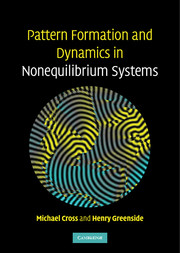Book contents
- Frontmatter
- Contents
- Preface
- 1 Introduction
- 2 Linear instability: basics
- 3 Linear instability: applications
- 4 Nonlinear states
- 5 Models
- 6 One-dimensional amplitude equation
- 7 Amplitude equations for two-dimensional patterns
- 8 Defects and fronts
- 9 Patterns far from threshold
- 10 Oscillatory patterns
- 11 Excitable media
- 12 Numerical methods
- Appendix 1 Elementary bifurcation theory
- Appendix 2 Multiple-scales perturbation theory
- Glossary
- References
- Index
Preface
Published online by Cambridge University Press: 05 August 2012
- Frontmatter
- Contents
- Preface
- 1 Introduction
- 2 Linear instability: basics
- 3 Linear instability: applications
- 4 Nonlinear states
- 5 Models
- 6 One-dimensional amplitude equation
- 7 Amplitude equations for two-dimensional patterns
- 8 Defects and fronts
- 9 Patterns far from threshold
- 10 Oscillatory patterns
- 11 Excitable media
- 12 Numerical methods
- Appendix 1 Elementary bifurcation theory
- Appendix 2 Multiple-scales perturbation theory
- Glossary
- References
- Index
Summary
This book is an introduction to the patterns and dynamics of sustained nonequilibrium systems at a level appropriate for graduate students in biology, chemistry, engineering, mathematics, physics, and other fields. Our intent is for the book to serve as a second course that continues from a first introductory course in nonlinear dynamics. While a first exposure to nonlinear dynamics traditionally emphasizes how systems evolve in time, this book addresses new questions about the spatiotemporal structure of nonequilibrium systems. Students and researchers who succeed in understanding most of the material presented here will have a good understanding of many recent achievements and will be prepared to carry out original research on related topics.
We can suggest three reasons why nonequilibrium systems are worthy of study. First, observation tells us that most of the Universe consists of nonequilibrium systems and that these systems possess an extraordinarily rich and visually fascinating variety of spatiotemporal structure. So one answer is sheer basic curiosity: where does this rich structure come from and can we understand it? Experiments and simulations further tell us that many of these systems – whether they be fluids, granular media, reacting chemicals, lasers, plasmas, or biological tissues – often have similar dynamical properties. This then is the central scientific puzzle and challenge: to identify and to explain the similarities of different nonequilibrium systems, to discover unifying themes, and, if possible, to develop a quantitative understanding of experiments and simulations.
A second reason for studying nonequilibrium phenomena is their importance to technology.
- Type
- Chapter
- Information
- Pattern Formation and Dynamics in Nonequilibrium Systems , pp. xiii - xviPublisher: Cambridge University PressPrint publication year: 2009

